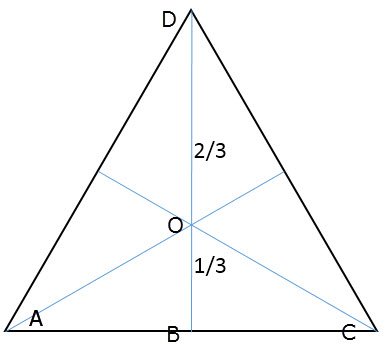Harley1980 wrote:
Engr2012 wrote:
BTW, I am interested in an alternate way to solve this question.
Yep, sure thing. As usual, geometry tasks have a lot of ways of solving

We have three points \((9, \ 2\sqrt{3})\), \((7, \ 0)\), and \((11, \ 0)\)
We have line at bottom from 7 to 11 and equidistant point between them (9) on the height \(\ 2\sqrt{3}\)
So we can infer that this is isosceles or equilateral triangle
Let's check it by finding distance between points \((9, \ 2\sqrt{3})\) and \((11, \ 0)\)
\((11-9)^2 + (0-\ 2\sqrt{3})^2 = distance^2\) --> \(4 + 12 = 16\) --> distance = 4
Line at bottom has length 4 and this second line has the same length so we have equilateral triangle.
Radius of circle which circumscribe equilateral triangle = \(\frac{a}{\sqrt{3}}\) where a is side of the equilateral triangle
Side of triangle equal to 4 so radius equal to \(\frac{4}{\sqrt{3}}\) and diameter equal to \(\frac{4*2}{\sqrt{3}}\)
---------------------------
P.S. I don't know why, but I didn't met this formula in Manhattan or Veritas, maybe I overlook it but just in case I explain how we can find this formula by ourself:
If we draw three heigths in equilateral triangle the intersection will be center of this triangle, also it will be center of circumsribed circle.
And as these heights split triangle symmetrically each height will be split on 2/3 and 1/3 parts
Attachment:
The attachment 2015-07-24 17-06-20 Presentation1 - PowerPoint.png is no longer available
And this 2/3 is a radius of circumscribed circle. So if we know height we can multiple it on 2/3 ang received a radius of circumscribed circle.
I think this ratio 2/3 to 1/3 is quite intuitive so I decide to not write long proof with pythagorean triangles.
P.P.S radius of circle inscribed in equilateral triangle equal to \(\frac{a}{2*\sqrt{3}}\) where a is side of the equilateral triangle
It is not a new or separate formula but a derivative of a formula that you already know about. The ratio of sides for 30-60-90 triangle.
When you draw the perpendicular from the top point (9,2sqrt3) to the base , you create 2 congruent 30-60-90 triangles (Triangles DBA and DBC) with sides in the ratio: \(1:\sqrt{3}:2\)
Additionally, when you draw the radius of the circumcircle, the radius (OA) bisects \(\angle{DAB}\) such that \(\angle{OAB} = 30.\)
Thus, in triangle, AOB, \(\angle{OAB} = 30\), as the radius of the circumcircle will bisect the angles of an equilateral triangle (you can figure it out by symmetry as well!)
Thus, triangle AOB , becomes another 30-60-90 triangle with ratio \(1:\sqrt{3}:2\) .
So , if the the side "sqrt{3}" = 2 units,
then the radius = R = side with "2" = \(\frac{4}{\sqrt{3}}\).
The property of '2/3' or '1/3' is a property of equilateral triangles and its altitudes. The altitudes in an equilateral triangle meet at the orthocenter, which divides the altitudes (or height or perpendiculars to the sides!) in the ratio 2/3 and 1/3 with 2/3 closer to the vertex. This is not a usual property of triangles and is thus not mentioned in most of the GMAT quant books. There will always be another way to solve such questions.
As an additional fun fact about equilateral triangles, the circumcenter, the incenter (center of the incircle) and the orthcenter all lie at the same point.
Attachments

2015-07-24_12-44-32.jpg [ 18.61 KiB | Viewed 15511 times ]



 95%
(hard)
95%
(hard)
 70%
(02:12)
wrong
70%
(02:12)
wrong  based on 525
sessions
based on 525
sessions











